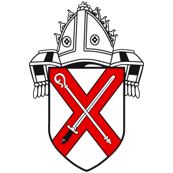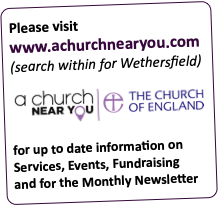Wethersfield
Parish Church


The beautiful thirteenth century parish church of St Mary Magdalene is situated on the High Street in Wethersfield, overlooking the village green.

Church services generally follow a repeating pattern every month.
|
1st Sunday |
11am |
Prayer & Pilgrimage (Celtic Morning Prayer) |
|
2nd Sunday |
11am |
Morning Prayer |
|
3rd Sunday |
8am |
Morning Prayer |
|
4th Sunday |
11am |
Eucharist |
|
Thursdays |
8:30am |
Morning Prayer |
Morning Prayer each Thursday is followed, at 9am, by informal meetings with Villagers.
If there is a 5th Sunday in a month, a United Benefice Service is held at 11am at one of the churches in the benefice.
If you would like a lift to any of the services in the benefice, or wish to receive holy communion at home, please contact the Parish Priest or the Churchwardens.
For details of the benefice Sunday School, please contact the Reader.
Please contact the Parish Priest for Baptisms, Marriages and when you are in need of help. During a difficult time there is always someone available to talk to you.
Communion may be brought to the homes of the sick and housebound.
Would newcomers to the village please make us aware of their presence.
Please contact us on the telephone numbers in Who's Who, or by email to
pastoral@wethersfieldchurch.org.uk
Any of the team would be happy to hear from you.
|
Parish Priest |
01371 810309 |
The Rev'd Alex Shannon |
|
Associate Minister |
01371 851317 |
The Rev’d Canon Janet Nicholls |
|
Reader |
01371 850781 |
Mrs Sarah Pilgrim |
|
Churchwardens |
07939 030833 |
Mr Ben Walmsley |
|
PCC |
|
|
|
Ringing Master |
01371 850481 |
Mr Roy Threadgold |
pastoral@wethersfieldchurch.org.uk
It may surprise you to know that the central church does not own the oldest public building in the village; the responsibility to maintain it, and the graveyard, is entirely that of those of us in the parish. We have to pay for its running costs and repairs.
It costs around £440 per week to keep St Mary Magdalene open, and we rely on standing orders, collections made during services and fundraising events for our income.
We are grateful for every contribution, however small. A regular gift helps us meet our obligations, particularly now that we are not making cash collections during services. If you feel able to assist, then the details are below.
Sort Code: 20 97 40 Account Number: 70950300
Account Name: St Mary Magdalene Wethersfield Parish Church
If you pay tax, then we can claim another 25% from the Government.
With your assistance we can conserve our beautiful and venerable building, not just for ourselves now, but for future generations.
gift@wethersfieldchurch.org.uk
The Parish of Wethersfield is committed to the safety and welfare of all who participate in our worship and other activities.
The PCC has adopted the House of Bishops’ Promoting a Safer Church: Safeguarding Policy Statement
Our Parish Safeguarding Officer is: Mrs S. Pilgrim, who may be contacted via safeguarding@wethersfieldchurch.org.uk
The Diocesan Safeguarding Team can be contacted by emailing safeguarding@chelmsford.anglican.org or by calling 01245 294490
If you have a safeguarding concern, you may also wish to contact the Essex Safeguarding Children Board:
Tel: 0345 603 7627 (Children & Families Hub)
Tel: 0345 606 1212 (Urgent & 24-hour Contact)
Email: escb@essex.gov.uk
Email: emergency.dutyteamoutofhours@essex.gov.uk
Further contact details can be found at Safeguarding Contacts
Wethersfield Parochial Church Council is the data controller (contact details below). This means it decides how your personal data is processed and for what purposes.
We use the personal data you provide on the electoral roll application form to enable us to manage, maintain and publish the electoral roll in accordance with Church Representation Rules (CRR) to:
We also need to collect your name and contact details when you attend a church service for Covid-19 Track and Trace purposes.
Your personal data will be shared within the institutional Church of England and with the general public.
We keep your personal data for 6 years after a complete review of the electoral roll, or, for Track and Trace purposes, for up to 1 month after the last service that you attended, unless you have otherwise given us verbal or written permission to keep it longer, for convenience.
Unless subject to an exemption you have the following rights with respect to your personal data:
privacy@wethersfieldchurch.org.uk
You can contact the Information Commissioners Office on 0303 123 1113 or via
email
or at the Information Commissioner's Office, Wycliffe House, Water Lane, Wilmslow, Cheshire. SK9 5AF.
Over £400 has been raised so far for our Church with no effort, by people who use our Easy Fundraising link when shopping online, at no cost to themselves.
If you've not signed up yet, please join today, and every time you shop online, at over 8,000 retailers like eBay, Argos, Marks and Spencer, John Lewis & Partners, Etsy, Tesco and Just Eat, those retailers donate to our cause, at no extra cost to you.
Sign up here: Easy Fundraising
St Mary Magdalene Wethersfield
Wethersfield takes its name from an old English personal name ‘Wutha’, probably the name of headman of a clan which settled here in the early Anglo Saxon period. It is first mentioned as a community in the Domesday Book which was compiled between 1086 and about 1120.
Wethersfield is a large parish, the Church being on high ground in the centre of the village. Wethersfield was a single manorial estate until it was divided into sub manors. Before the Norman Conquest in 1066 the Earl of Mercia owned most of the village but it was given to a Frenchman named Picot after the Conquest. It is likely that a Church was built here in the Earl’s time, and traces of what is considered to be an Anglo Saxon Church can be seen in the thickness of the wall in the North West corner of the nave. We can be reasonably certain that there has been a place of worship here for at least one thousand years. If only five burials took place each year during that time, some five thousand Wethersfield people lie within a few yards of this building.
The Parish Church is mainly C12 to early C15. Beginning as a smallish, ill lit, Anglo Saxon Church, probably just a nave and chancel, it was augmented about the year 1200 by a massive low rise tower stretching the full width of the nave. The tower survives largely intact from that time. Complete with its original window openings, doorway and door. The wall of the nave was later pierced to form an arcade, and a south aisle was constructed at the same time.
About one hundred years later the same thing happened on the north side; the south aisle was also lengthened. It is likely that the construction of the two aisles coincided with peaks in population growth. The chancel was rebuilt around 1340, a few years before the Black Death (1348) reduced the population by at least a third, perhaps as much as half. You will see that the Chancel has the axis deflected to the north, usually it would be deflected to the south.
In about the year 1400 the south aisle was rebuilt and the south porch was added to it, fifty years later a porch was added to the north aisle of the Church. The nave was probably as gloomy as the chancel until a clerestory was added in the C16. Little further structural change occurred until 1750 when the north porch was rebuilt. Between 1872 and 1877 the Church was restored and an organ chamber and vestry were built on the south side of the Church. Ewan Christian, a nationally known Church architect, oversaw the restoration.
At ground level in the Tower there is a feature that may be unique in Essex, this is the so called ‘Samson post’, a massive timber post, probably of the C17 which supports the floor above and the wooden frame of the spire. Such posts were more commonly used in the construction of wooden ships. The C14 north door is original.
There are eight bells in the tower, one dated 1623 is by Miles Graye 1 of Colchester, who was known as the ‘prince of founders’. He was the first of three generations of founders all named Miles Graye who produced bells for nearly a century. When Miles 1 died in 1649 he was, to use his own words, ‘crazed with age but of perfect mind and memory’.
The font used in the Church today is a Victorian replica of the disused 14C font now situated almost next to it. It was situated for many years in the south porch and was brought in to its present position as the south porch is now converted into the toilet area.
There are fragments of C14 glass collected in several windows in the Church. There is also some later glass including the badge of Anne Boleyn in the windows of the south aisle. The badge consists of a crowned falcon holding a sceptre.
In the chancel there is a C17 communion table. The rood screen is mainly C15 but has been much restored. There are two ‘sedilia’ (vicar’s seats) in the south wall of the Chancel and a double ‘picinae’ with two drains (stone wash bowls) they are well preserved and date from the C14.
The principle monument in the church is also in the chancel on the north side. It consists of an altar tomb with alabaster effigy of a man, probably Henry Wentworth, in plate armour, his feet resting on a unicorn (minus the horn) and the effigy of a woman (probably Elizabeth Howard, his first wife) in a long cloak and wearing a necklace of roses. You will see that the effigies still retain traces of their original colouring and gilding, but in addition to this they are covered with an extraordinary number of graffiti. Scratched into the soft alabaster, these initials and dates (many from the C17) totally disfigure the effigies and remind us that graffiti are not a new problem.
Above the tomb, balanced on what appears to be the original iron bracket is a C16 helmet with a unicorn crest. Such helmets are very flimsy and were made especially for funerals. Close to the Wentworth tomb are some high quality floor slabs which cover the graves of the Mott family who were generous benefactors to the poor of this parish in the C18.
Two Wethersfield worthies must be mentioned. The first is a man named Patrick Punty, born a Gaelic speaking Catholic in County Down, he transformed himself into Patrick Brontë, a Church of England clergyman who was curate here from 1806 to 1809. He was of course father of the Brontë sisters. The Brontë Society unveiled a plaque in his memory by the south door some years ago. The second worthy is Captain Charles Clerke, son of a Wethersfield farmer, who accompanied Captain James Cook on four expeditions. Having witnessed Captain Cook’s murder in Hawaii, Clerke took command of the expedition but died of TB on his way home to England.
St Mary Magdalene is, like all our parish Churches, unique in its own right and reflects the care given to it today and for the last thousand years by the people of Wethersfield.
John Townrow